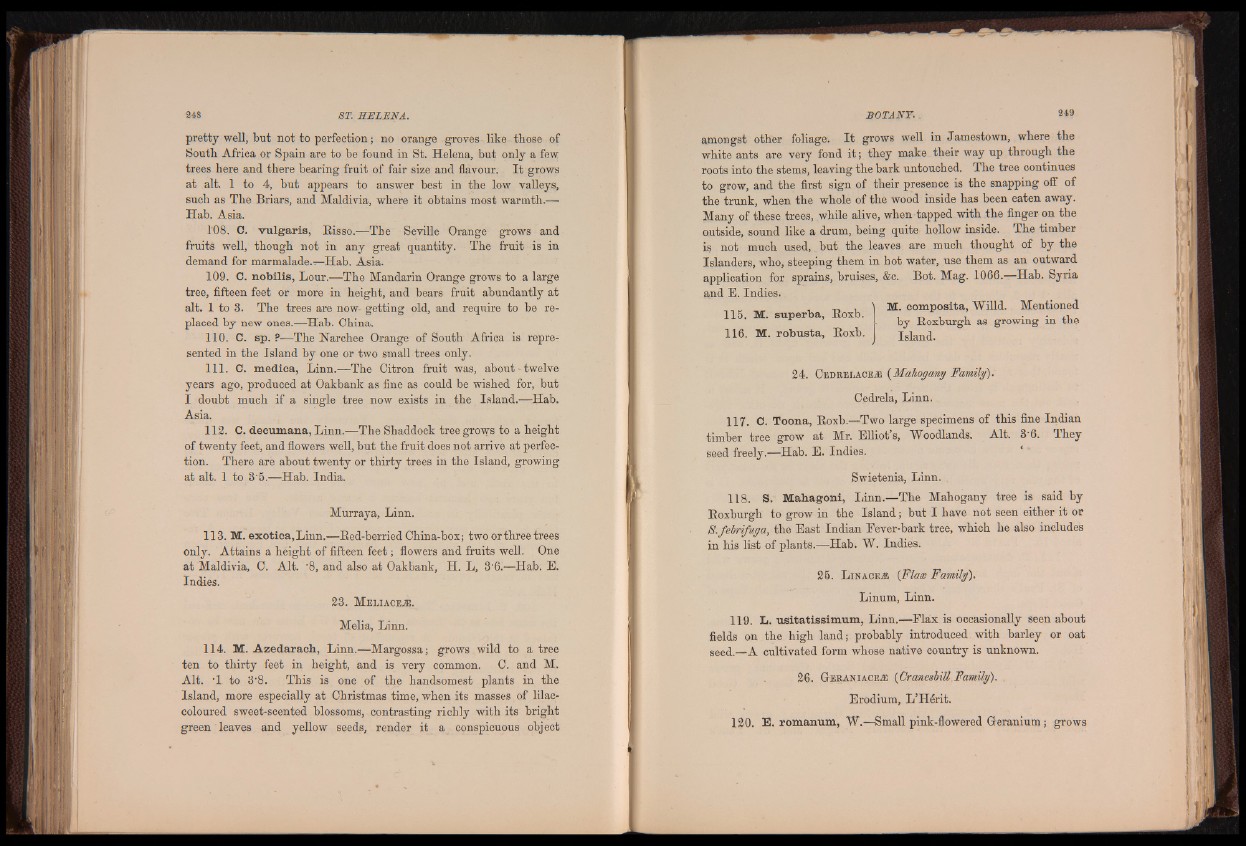
pretty well, but not to perfection; no orange groves like those of
South Africa or Spain are to be found in St. Helena, but only a few
trees here and there bearing fruit of fair size and flavour. I t grows
at alt. 1 to 4, but appears to answer best in the low valleys,
such as The Briars, and Maldivia, where it obtains most warmth.—
Hab. Asia.
108. C. v u l g a r i s , Risso.—The Seville Orange grows and
fruits well, though not in any great quantity. The fruit is in
demand for marmalade.—Hab. Asia.
109. C. n o b i l i s , Lour.—The Mandarin Orange grows to a large
tree, fifteen feet or more in height, and bears fruit abundantly at
alt. 1 to 3. The trees are now- getting old, and require to be replaced
by new ones.—Hab. China.
110. C. s p . ?—The Narchee Orange of South Africa is represented
in the Island by one or two small trees only.
111. C. medica, Linn.—The Citron fruit was, about-twelve
years ago, produced at Oakbank as fine as could be wished for, but
I doubt much if a single tree now exists in the Island.—Hab.
Asia.
1 1 2 . C. d e c u m a n a , Linn.— The Shaddock tree grows to a height
of twenty feet, and flowers well, but the fruit does not arrive at perfection.
There are about twenty or thirty trees in the Island, growing
at alt. 1 to 3'5.—Hab. India.
Murraya, Linn.
113. M . e x o t i c a , Linn.—Red-berried China-box; two or three trees
only. Attains a height of fifteen feet; flowers and fruits well. One
a t Maldivia, C. Alt. '8, and also at Oakbank, H. L, 3-6.—Hab. E.
Indies.
2 3 . M b l ia c e jE,
Melia, Linn.
114. M . A z e d a r a c h , Linn.—Margossa; grows wild to a tree
ten to thirty feet in height, and is very common. C. and M.
Alt. '1 to 3-8. This is one of the handsomest plants in the
Island, more especially at Christmas time, when its masses of lilac-
coloured sweet-scented blossoms, contrasting richly with its bright
green leaves a n d yellow seeds, render it a conspicuous object
amongst other foliage. I t grows well in Jamestown, where the
white ants are very fond it; they make their way up through the
roots into the stems, leaving the bark untouched. The tree continues
to grow, and the first sign of their presence is the snapping off of
the trunk, when the whole of the wood inside has been eaten away.
Many of these trees, while alive, when tapped with the finger on the
outside, sound like a drum, being quite hollow inside. The timber
is not much used, but the leaves are much thought of by the
Islanders, who, steeping them in hot water, use them as an outward
application for sprains, bruises, &c. Bot. Mag. 1066.—Hab. Syria
and E. Indies.
. I M . c om p o s i 116. ta , Willd. Mentioned M . s u p e r b a , Roxb. b, y Roxburg,h as grow. ing i. n t,h, e|i
116. M. robusta, Roxb. I Island.
2 4 . Cedrelacete (Mahogany Family).
Cedrela, Linn.
117. C. T o o n a , Roxb—Two large specimens of this fine Indian
timber tree grow at Mr. Elliots, "Woodlands. Alt. 3 6. They
seed freely.—Hab. E. Indies.
Swietenia, Linn.
118. S . M a h a g o n i , Linn.—The Mahogany tree is said by
Roxburgh to grow in the Island; but I have not seen either it o r
S.febrifuga, the East Indian Fever-bark tree, which he also includes
in his list of plants.^sHab. W. Indies.
2 5 . Linages (Flax Family).
Linum, Linn.
119. L . u s i t a t i s s im u m , Linn.— Flax is occasionally seen about
fields on the high land; probably introduced with barley or oat
seed.—A cultivated form whose native country is unknown.
26. GeraniaceAS (CranesbiU Family).
Erodium, L’Herit.
120. E . romanum, W.—Small pink-flowered Geranium; grows